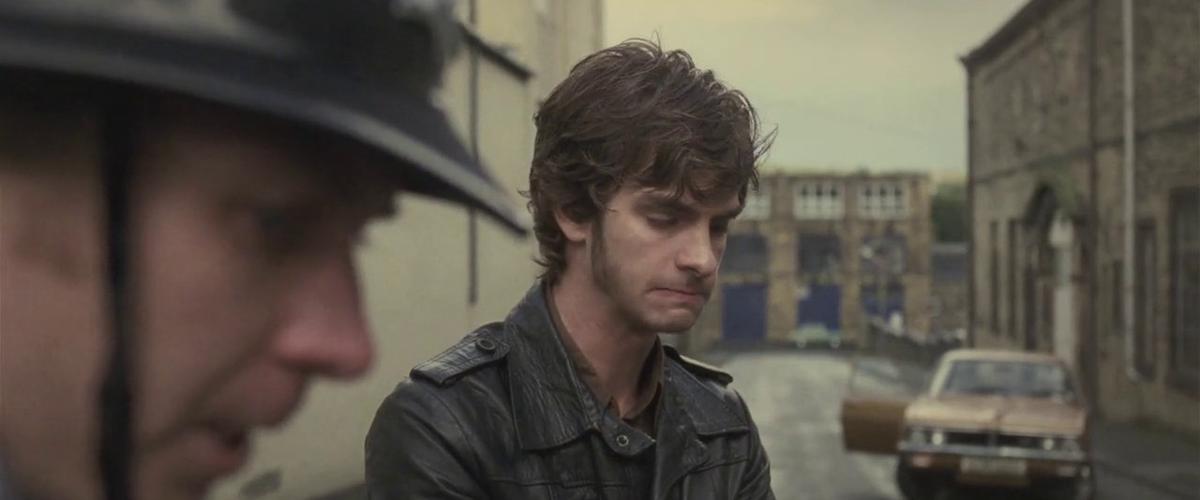By Chlotrudis Independent Film Society
Rating: 4.5 cats
Director: Julian Jarrold
Starring: Andrew Garfield | Anthony Flanagan | David Morrissey | Jennifer Hennessey | John Henshaw | Warren Clarke

Country: united_kingdom
Year: 2010
Running time: 102
IMDB: http://www.imdb.com/title/tt1259574/
Jason says: “The RED RIDING trilogy is a daunting prospect, especially if one is inclined to see it during its brief American theatrical release as opposed to as a video on demand offering or on DVD. I’d recommend it, as it’s a fine piece of work and everything is better in the theater, but finding the five hours can be tough. So start with just committing to the first; it’s the tightest and most self-contained, and thus will either be a satisfactory experience on its own or will serve as motivation to find time for the rest.
“As the subtitle tells us, it is ‘The Year of Our Lord 1974.’ The place is Yorkshire. A nine-year-old girl has disappeared, and Eddie Dunford’s father has died. Eddie (Andrew Garfield) is coming home not just for his funeral, but taking a job with the local newspaper after a brief time in London. Naturally, one of his first assignments is the Kemplay girl’s disappearance, and while the senior crime reporter, Jack Whitehead (Eddie Marsan) has a close relationship with the local constabulary, Eddie finds himself more sympathetic with colleague Barry Gannon (Anthony Flanagan), who sees conspiracies around every corner, particularly in developer John Dawson (Sean Bean) and his plan to build a shopping plaza on land currently occupied by gypsies. Eddie finds that this may be the third girl in the area to go missing in five years, and his attempt to interview the mother of one of the missing girls, Paula Garland (Rebecca Hall), gets him a visit from coppers Bob Craven (Sean Harris) and Tommy Douglas (Tony Mooney). Only she says she never complained to the police…
“RED RIDING: 1974 is a murder mystery, for certain, although it’s not one that’s too terribly difficult to puzzle out. As horrifying as the crime in question is, though, it’s not really what the film is about. Plotwise, the girl’s disappearance soon becomes a terrible part of something more pervasive, too large to be contained by just one film, although the story will not feel incomplete after two hours. But even more than the conspiracy, the film is about Eddie and Paula – who they are as people, who they can become, and what they could mean to each other.
“Andrew Garfield is just what the movie needs as Eddie; he comes into the movie with a young man’s cynicism, resenting how respected his father is, acting like he knows it all despite the fact that he washed out of the big time and makes a fairly serious blunder or two along the way. He’s more than a bit of a jerk, and yet, somewhere underneath that, we see the other traits of youth come through – idealism, belief that he can change the world for the better, compassion. It is, in some ways, the reverse of the path one might expect for a movie packed with vice, corruption, and betrayal, and that is part of what makes Garfield’s Eddie the most memorable of the series’s protagonists; we believe him even as he makes growing up a positive.
“It’s a bit of time before Rebecca Hall shows up, but she is also oddly captivating. We know who she is, of course; the young mother who has seen everything in her life destroyed is a familiar type. What sets Paula apart is how Hall plays an aspect of the character that screenwriter Tony Grisoni never quite has anybody say out loud, that she is still young and capable of starting over. She never says anything like that, and we never get the sense that she wants to leave any part of her old life behind, but there is a sense that, along with grief, she’s oppressed by the town’s pity, their inability to see her as anything but the poor woman whose daughter disappeared, and that part of her attraction to Eddie is that, even though he’s investigating that disappearance, he’s also seeing her as an attractive woman rather than seeing her as incomplete.
“The rest of the cast is very good; many won’t have their characters fully fleshed-out until later films, but several make an impression: Flanagan’s paranoid reporter, John Henshaw’s editor, Peter Mullan’s friendly and unorthodox preacher. Then there’s Cathryn Bradshaw and Sean Bean as the Dawsons. Bradshaw makes wife Marjorie a disturbed wreck, while Bean has bulked up since his leading-man days, and there’s a palpable sense of his character’s power whenever he walks into a scene.
“Interesting, 1974 is the only film in the series to be presented in the standard HD television ratio, at least in the theater where it played in Cambridge, MA. It is a visually arresting film, though, with every inch of the frame putting us into mid-seventies Yorkshire. There’s a sense of the poverty and decay, with the coal plants looming over the mining town. A scene where Eddie walks through a gypsy camp that has been burnt down feels like a trip through a war zone. Director Julian Jarrold also does an excellent job of planting things for the other filmmakers to use, without being too obvious about it, even though at least one moment will have the audience kicking themselves for not picking up on it during 1983.
“It’s a grim story he creates, even if it does have the seeds of redemption inside. If 1974 is all you can see of Red Riding, you’ll get a satisfying experience, but, fortunately, there’s another three-plus hours of connected crime to look forward too. 4 1/2 cats
“Seen 21 February 2010 at Landmark Kendall Square #9 (first-run)”
